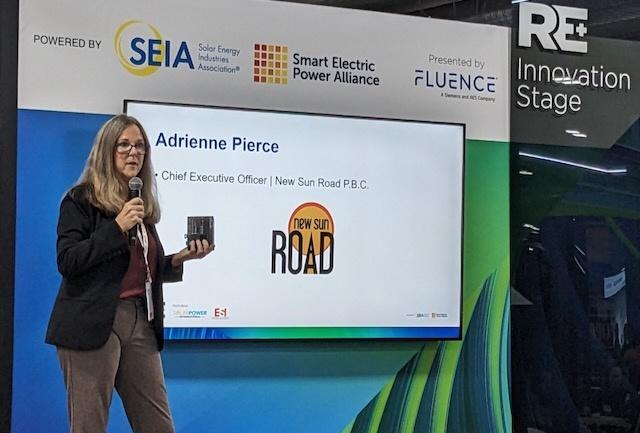Imagine you’re a utility company in California serving 16 million customers across 70,000 square miles.
Your power grid can be strained by climate-related disasters, wildfires and heat waves. And the electric load is expected to grow by at least 70% in the next 20 years, much of that from transportation and building electrification.
Preventing wildfires, expanding clean power capacity and reducing the frequency of power shutoffs: This is the urgent mandate of Pacific Gas and Electric Company (PG&E) and, like many large enterprises, it’s looking to smaller companies to help them innovate.
Enter New Sun Road, a clean energy startup whose technology is managing power systems in over 22 countries.
In 2021, it partnered with PG&E to provide its Stellar Microgrid OS, a remote monitoring and control platform, for PG&E’s first hybrid renewable energy standalone power systems in the hamlet of Briceburg, where transmission lines were lost in a 2019 fire.
Part of their wildfire mitigation efforts and system hardening program, these remote grids have improved resilience and safety in high-fire risk areas. The system in Briceburg provides more than 95% renewable power and 100% up-time.
Still, PG&E and New Sun Road could not be more different: One, a large complex, process-driven, 100-year old corporation; the other, a nimble startup with deep expertise in renewable energy systems, remote data processing and AI optimization.
I spoke with New Sun Road’s CEO Adrienne Pierce to learn what made the partnership a success.
Renita Kalhorn: Collaborating with a corporation is challenging enough but partnering with a public utility must be particularly so.
Adrienne Pierce: We hear that a lot! But Patti Poppe, the new CEO of PG&E, has acknowledged that big companies don’t do innovation well: their job is to be a good customer. And that’s what they’ve been.
Renita: So let’s talk about what’s worked.
Adrienne: Well, as you know, in a large organization, all the functions are specialized, there are procedures designed for every eventuality. One critical thing PG&E did is designate a dedicated, empowered senior product manager.
Renita: I bet that helped you navigate all the moving parts.
Adrienne: Absolutely. For example, to test 20 of PG&E’s alarms on our Stellar platform, we needed someone on the PG&E side to add the alarms to the admin dashboard. Our point-of-contact, Alex Collins, a seasoned software engineer, didn’t hesitate. Knowing this was a project-defined goal, he worked with us directly to get it done so the testing could move forward without getting bogged down.
Renita: So he had authority to make decisions.
Adrienne: Exactly. It’s important that the dedicated person has a certain status within the organization.
As another example: when the IT department was making certain demands around cybersecurity concerns, Alex could advocate for us and say, “This doesn’t really apply because remote grids are distributed and not centrally integrated in the larger grid so they’re lower risk.”
All these issues add up. Each one can slow the project creating delays, a lot of back-and-forth and frustration among the team members.
Renita: I can imagine! Another common challenge in corporate-startup partnerships is the different timeframes. How did you manage that?
Adrienne: As with any new project, there are legal contracts and terms of conditions. But instead of starting from scratch, we leveraged scopes of work and test plans already agreed upon.
For example, our first project was a prototype micro-grid in the Sierra Nevada at Briceburg. So after winning in a competitive bidding process our partnership expanded and includes all of PG&E’s remote grids. We used the proven Briceburg example as the baseline.
By keeping the majority of what we had already agreed upon, it made the process faster and more efficient. Instead of taking months to go to all the different departments to get their input and authorization, we were able to put together a draft contract in less than 60 days.
Renita: So resourceful! I often see corporations select startups to invest in or partner with through an innovation competition. But if the beta project doesn’t go well and the executives are not championing it, it quietly dies.
Adrienne: So true. The key to success is to tie these collaborations directly to business units and strategic objectives. This is the best way for large organizations to really commit to investing resources in building the relationship and integrating the technology that they need. In our case, we’re part of PG&E’s remote grid program associated with wildfire mitigation and system hardening.
Renita: And they can better weigh the costs and benefits of the program, I imagine.
Adrienne: Exactly. For PG&E, it’s an attractive alternative to putting distribution lines underground — which can cost upwards of $3 million a mile, depending on the location — while providing reliable, clean power in rural locations. And the remote control and monitoring we provide helps them manage all the systems from one dashboard.
Renita: Such an inspiring success story. Where do you see the partnership going?
Adrienne: Well, PG&E is currently managing six remote grids with our platform, and plans to deploy a total of 30 remote grids by 2026. We’ve proposed adding EV charging to the remote grids as well as AI optimization. Having a committed, technically sophisticated partner stretches us too, to ensure the integrity and expand the capabilities of our platform. I hope that this can serve as a model for other startup-corporate collaborations to accelerate the clean power we all need.
Read the full article here










